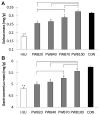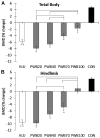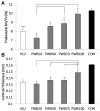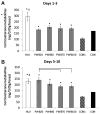Partial reductions in mechanical loading yield proportional changes in bone density, bone architecture, and muscle mass
- PMID: 23165526
- PMCID: PMC4118556
- DOI: 10.1002/jbmr.1814
Partial reductions in mechanical loading yield proportional changes in bone density, bone architecture, and muscle mass
Abstract
Although the musculoskeletal system is known to be sensitive to changes in its mechanical environment, the relationship between functional adaptation and below-normal mechanical stimuli is not well defined. We investigated bone and muscle adaptation to a range of reduced loading using the partial weight suspension (PWS) system, in which a two-point harness is used to offload a tunable amount of body weight while maintaining quadrupedal locomotion. Skeletally mature female C57Bl/6 mice were exposed to partial weight bearing at 20%, 40%, 70%, or 100% of body weight for 21 days. A hindlimb unloaded (HLU) group was included for comparison in addition to age-matched controls in normal housing. Gait kinematics was measured across the full range of weight bearing, and some minor alterations in gait from PWS were identified. With PWS, bone and muscle changes were generally proportional to the degree of unloading. Specifically, total body and hindlimb bone mineral density, calf muscle mass, trabecular bone volume of the distal femur, and cortical area of the femur midshaft were all linearly related to the degree of unloading. Even a load reduction to 70% of normal weight bearing was associated with significant bone deterioration and muscle atrophy. Weight bearing at 20% did not lead to better bone outcomes than HLU despite less muscle atrophy and presumably greater mechanical stimulus, requiring further investigation. These data confirm that the PWS model is highly effective in applying controllable, reduced, long-term loading that produces predictable, discrete adaptive changes in muscle and bone of the hindlimb.
Copyright © 2013 American Society for Bone and Mineral Research.
Conflict of interest statement
All authors state that they have no conflicts of interest.
Figures







Similar articles
-
Sclerostin antibody inhibits skeletal deterioration due to reduced mechanical loading.J Bone Miner Res. 2013 Apr;28(4):865-74. doi: 10.1002/jbmr.1807. J Bone Miner Res. 2013. PMID: 23109229 Free PMC article.
-
Multiple exposures to unloading decrease bone's responsivity but compound skeletal losses in C57BL/6 mice.Am J Physiol Regul Integr Comp Physiol. 2012 Jul 15;303(2):R159-67. doi: 10.1152/ajpregu.00499.2011. Epub 2012 May 16. Am J Physiol Regul Integr Comp Physiol. 2012. PMID: 22592559 Free PMC article.
-
Partial weight suspension: a novel murine model for investigating adaptation to reduced musculoskeletal loading.J Appl Physiol (1985). 2010 Aug;109(2):350-7. doi: 10.1152/japplphysiol.00014.2009. Epub 2010 Jun 3. J Appl Physiol (1985). 2010. PMID: 20522735 Free PMC article.
-
Hindlimb unloading of growing rats: a model for predicting skeletal changes during space flight.Bone. 1998 May;22(5 Suppl):83S-88S. doi: 10.1016/s8756-3282(98)00019-2. Bone. 1998. PMID: 9600759 Review.
-
The effect of exercise and nutrition on the mechanostat.J Musculoskelet Neuronal Interact. 2005 Jul-Sep;5(3):239-54. J Musculoskelet Neuronal Interact. 2005. PMID: 16172515 Review.
Cited by
-
Osteoporosis therapy: a novel insight from natural homeostatic system in the skeleton.Osteoporos Int. 2015 Feb;26(2):443-7. doi: 10.1007/s00198-014-2923-y. Epub 2014 Oct 7. Osteoporos Int. 2015. PMID: 25288445 Review.
-
RNAseq and RNA molecular barcoding reveal differential gene expression in cortical bone following hindlimb unloading in female mice.PLoS One. 2021 Oct 12;16(10):e0250715. doi: 10.1371/journal.pone.0250715. eCollection 2021. PLoS One. 2021. PMID: 34637435 Free PMC article.
-
The ratio of anterior and posterior vertebral heights reinforces the utility of DXA in assessment of vertebrae strength.Calcif Tissue Int. 2014 Aug;95(2):112-21. doi: 10.1007/s00223-014-9868-1. Epub 2014 May 23. Calcif Tissue Int. 2014. PMID: 24854155 Free PMC article.
-
Identification of the molecular link: STAT3 is a shared key gene linking postmenopausal osteoporosis and sarcopenia.Bone Joint Res. 2024 Aug 28;13(8):411-426. doi: 10.1302/2046-3758.138.BJR-2023-0351.R2. Bone Joint Res. 2024. PMID: 39195444 Free PMC article.
-
Treatment With a Soluble Bone Morphogenetic Protein Type 1A Receptor (BMPR1A) Fusion Protein Increases Bone Mass and Bone Formation in Mice Subjected to Hindlimb Unloading.JBMR Plus. 2017 Oct 9;1(2):66-72. doi: 10.1002/jbm4.10012. eCollection 2017 Oct. JBMR Plus. 2017. PMID: 30283882 Free PMC article.
References
-
- Frost HM. Perspectives: a proposed general model of the “mechanostat” (suggestions from a new skeletal-biologic paradigm) Anat Rec. 1996;244(2):139–47. - PubMed
-
- Frost HM. Bone “mass” and the “mechanostat”: a proposal. Anat Rec. 1987;219(1):1–9. - PubMed
-
- Robling AG, Castillo AB, Turner CH. Biomechanical and molecular regulation of bone remodeling. Annu Rev Biomed Eng. 2006;8:455–98. - PubMed
-
- Morey-Holton E, Globus RK, Kaplansky A, Durnova G. The hindlimb unloading rat model: Literature overview, technique update and comparison with space flight data. Adv Space Biol Med. 2005;10:7–40. - PubMed
-
- Tuukkanen J, Wallmark B, Jalovaara P, Takala T, Sjögren S, Väänänen K. Changes induced in growing rat bone by immobilization and remobilization. Bone. 1991 Jan 1;12(2):113–8. - PubMed
Publication types
MeSH terms
Substances
Grants and funding
LinkOut - more resources
Full Text Sources
Other Literature Sources
Medical

